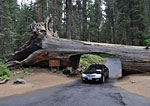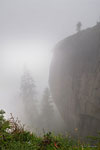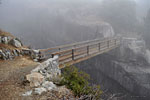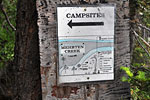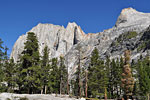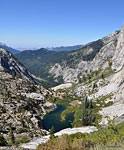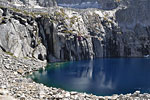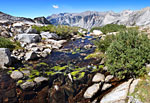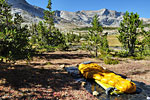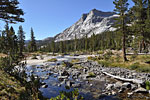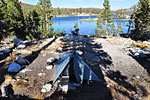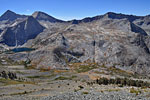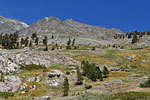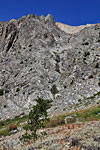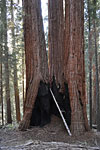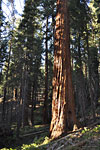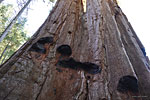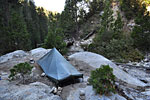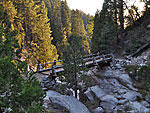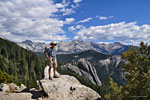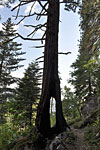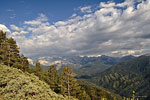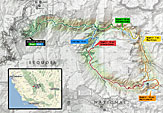 |
|
| The Great Western Divide, Sequoia National Park, CA via High Sierra Trail & Black Rock Pass Trail 5 day, 64 mile lasso loop through some of the most breathtaking terrain in the Sierra Nevada |
This epic hike is a loop route that immerses you in what is arguably the most breathtaking region of the entire Sierra Nevada - Kaweah Gap and Black Rock Pass over the Great Western Divide. Some of the highlights include Valhalla, a high valley of immense stone walls encompassing the Hamilton Lakes, the deep blue Precipice Lake and the amazing vista on the climb to Kaweah Gap, the remote Nine Lakes basin and wide, lush Big Arroyo valley, the pristine, peak-lined Big and Little Five Lakes areas, the spectacular panorama from Black Rock Pass of stair step lakes nestled among jagged granite monoliths, and Redwood Meadow, where you can experience the massive scale of the planets largest living things up close. All through this rugged wilderness, you'll cross countless noisy cascades tumbling from great heights, skirt numerous virgin meadows teaming with colorful varieties of foliage and flowers,and of course, be joined by hungry black bears, brazen deer, scolding jays, bushy marmots, frisky chipmunks, endearingly curious lizards and Kamikaze grasshoppers. The Great Western Divide is the appropriately imposing moniker bestowed upon a towering north-to-south range of rugged Sierra Nevada peaks in central California's Sequoia/Kings Canyon National Park (SEKI), two separate, adjacent wildernesses that are managed as one. This vast and remote mountain range is accessible only on foot or stock as there are no roads within a dozen miles. Here, a handful of chiseled footpaths climb steep mountain passes to offer some of the most jaw-dropping scenery in the entire Sierra, in all of California, in the whole USA. One of these trails, the High Sierra Trail (HST) begins in the Giant Forest region on the western edge of Sequoia NP, and ends at it's junction with the John Muir Trail to Mt. Whitney, the highest peak in the contiguous USA, a distance of approximately 50 miles. This well-maintained route begins among immense Giant Sequoia's, penetrates deep sugar pine forests on cliff-edged, cascade-carved canyons, skirts dozens of wondrously deep blue lakes and climbs far above tree line into the rocky alpine high country before descending into an immense round-walled valley and on to the Kern River. From the trailhead in Crescent Meadows, the pine needle-covered soft dirt path hugs the contours of the mountains beneath a welcomingly shady canopy of thick forest. The High Sierra Trail starts high up on a mountain and the trail builders did a good job of keeping elevation changes to a minimum, avoiding numerous and tiring climbs and descents. After Bear Paw Meadow, home of the only High Sierra Camp in Sequoia NP and the Bear Paw Meadow Ranger Station, the climb up to Valhalla and Hamilton Lakes, the first night's destination, becomes more steep, rocky and challenging as the trail ascends the deep granite canyon to Kaweah Gap. On the second day, the climb from Hamilton Lake to the top of the gap is an elevation gain of 2300 feet in under 3 miles, enough exertion to limit high mileage gains afterwards. East of the gap, there is the rugged and exposed Nine Lakes Basin to explore, if you have more energy to climb further above tree line to make camp, or a descent into lush Big Arroyo beside a tree-lined river. |
Day three is due south toward Little Five Lakes, to experience the awesome massif high above the eastern side of The Arroyo containing the Kaweahs: Black Kaweah, Red Kaweah, Second Kaweah and 13,802 foot Mt. Kaweah, the highest peak in the park. It's here we leave the High Sierra Trail and climb up to the Little Five Lakes area. Around and up the mountain south of Little Five Lakes lie the remote and pristine Big Five Lakes, campsite for the third night, guarded by a massive, towering pyramid of granite. Day four entails backtracking 3 miles to the Little Five Lakes and then the daunting 1200 ft. climb out of tree line up steep Black Rock Pass, from where you say farewell to the rugged Kaweah Range and hello to the immense and impressive Cliff Creek valley on the Black Rock Pass trail. The long descent from the pass allows plenty of opportunity to marvel at the wide, deep valley, taking in the stair step lakes of Columbine, Cyclamen and Spring Lakes, cascading into one another, surrounded by ruggedly steep peaks and cliffs and glacially carved terrain. Many waterfall, stream and meadow-filled miles lower, Black Rock Pass trail descends into thick forest again, where the fourth nights camp will be creek side among towering sugar pines. Day five begins with a 1500 ft. climb to Bear Meadows, where you rejoin the High Sierra Trail back to Crescent Meadows. September is typically a month of dramatic change in the Sierra - daytime temperatures are routinely in the '90's and the nights get increasingly cooler, with marked differences at higher altitudes. As the hot summer days give way to fall, the rains come back to the high country and the nighttime alpine temperatures drop toward freezing. The animals become more active and noticeable as they prepare for winter. The mosquitoes, swarming throughout the spring and summer, have mostly disappeared. September is usually the last month to hike the Sierra backcountry with 3 season gear, but freak storms can and do happen at anytime in these mountains. It is folly to underestimate the severity of a mountain wilderness storm, as many unprepared backcountry adventurers are no longer around to attest to. From mid-September to the end of the month, monitor forecasts religiously, plan on days of rain and hope for the best. Sierra days typically stay warm into October, but precipitation usually means snow has fallen on the high passes and carrying winter gear is necessary to cross them safely. |
Because of the legendary beauty of Sequoia National Park and the Great Western Divide, it can be challenging to score a Wilderness Permit for this hike from Crescent Meadows. I made my reservation online almost 5 months in advance and still couldn't get a weekend departure date. But Monday is an ideal start day for a long hike as the majority of the weekend crowds have left and you can enjoy the wonders of this amazing area without waiting in line, getting stuck in traffic or struggling to find a parking spot. This would be my third solo backpacking trip to Sequoia/Kings Canyon (SEKI) National Park this summer. My Memorial Day weekend hike from Big Meadow/Horse Corral to check out the Roaring River area was likely the first hiker trip of the year to that area since the park opened that weekend, before the backcountry rangers arrived. In August, I spent an incredible week hiking to Rae Lakes and the Sixty Lakes basin, from Roads End in the north of the park. And this mid-September trip would end 3 days after the backcountry rangers had packed and gone home for the season.
After carefully scrutinizing my topo map, adding up elevation and mileage, I tentatively planned on 6 days and 5 nights, with an extra days rationing in case things got interesting. The plan was to take it easy and explore off-trail as much as I wanted. I didn't want this to be a trail-pounding hike, constrained by time and distance goals. I made some loose daily destination estimates, but otherwise, I'd play it by-ear and make decisions about where I'd stay and for how long on the fly. I was concerned that numerous wild fires of late would hamper visibility and detract from the natural beauty I'd come for, but I posted my concerns on some hiking forums, and spoke with rangers on the phone and was assured by several people that Sequoia NP's skies were clear.
I took my Osprey Exos 58 backpack on this trip, which weighs 2.5 lbs. Total full pack weight including 1.5 liters of water, 20 oz. electrolyte drink bottle, and food and fuel for 6 days, 5 nights was 30 lbs., 8oz., of which 8 lbs., 13oz. was a large bear cannister (2lbs. 9.5 oz) and food (6lbs., 3.5oz). In addition to a Nikon DSLR in a holster case attached across my chest to the shoulder straps and a Garmin GPS unit in a pocket on my pack belt, I also carried trek poles, a pocketknife, compass and topo map. I'm constantly refining my gear list to reduce weight without detracting from a high level of camping comfort that I prefer (e.g.- my collapsible pillow). Here's a pdf of my 2009 3-season gear list for 5 nights in the Sierra that works well for me, which you can download if you're interested. A couple of things, like the extra tent pole, pertains to my particular gear setup.
I left LA on Sunday afternoon for the 215 mile drive north through Bakersfield and Visalia to the park's southern entrance at the town of Three Rivers, where they took my $20 for a one week stay. There is only one through-highway in Sequoia NP, Hwy. 198 or the Generals Highway. It winds up through the mountains from north to south in the far western region of the park, a twisty, slow, 2 lane road that accesses all the park's attractions including the fantastic
It was overcast and partly sunny when I arrived at Sequoia's Three River entrance late Sunday afternoon, and started drizzling soon after. But the National Weather Service (noaa.gov) had forecast clear and sunny skies for the remainder of the week. I was well-rewarded when their predictions became accurate. On a week-long hike, I don't mind a day of light rain to wash away the haze, cool things down and brighten up the wilderness — preferably the day before I arrive! After a cleansing rain, the skies are luminous, the air is crisp and fresh, the streams and lakes are more vibrant, the animals more animated, and the forest is rejuvenated with exuberant life.
| Day 1: Crescent Meadows to Bear Paw Meadow to Upper Hamilton Lake - 16 mi., +2400 / -800 ft. | |||||
|
| Day 2: Hamilton Lake to Kaweah Gap, Nine Lakes and the Big Arroyo - 7 mi., +2300 / -750 ft. | |||||||||||||||||||||||||
|
|||||||||||||||||||||||||
|
| The trails in Sequoia/Kings Canyon National Park are well-maintained and signed. On this hike route, there are 7-8 bridges over creeks, gorges and wetlands and even a tunnel. The High Sierra Trail from Crescent Meadows to the junction with the spur trail to Black Rock Pass is about 30 miles. The first 11 miles are packed dirt/pine needles and relatively level. Beyond Bearpaw Mdw., it becomes mostly jagged stone and rock as it climbs up to Kaweah Gap and Black Rock Pass. In the Big Arroyo and Little/Big Five Lakes and the Cliff Creek Trail, it's mostly hard pack dirt and gravel. Over 5 days, and 64 miles, total elevation gain/drop was approx. 9500 ft. up, 8400 ft. down. Water is available year round on this loop route, from numerous lakes and stream crossings every mile or two. |
In most of the park, permit holders have free reign to camp pretty much where you want, as long as you follow the basics - e.g., 100 ft. from water, use existing sites when you can, etc. The Ranger goes over the rules when you get your permit. In some places, like Hamilton Lake, you're required to camp in the designated campsites. |
| From north Los Angeles, it's approximately 215 miles to the parks southwest entrance at Three Rivers, CA. It took me 3 1/2 hours up I-5, Hwy. 99 through Bakersfield and then Hwy. 198 east out of Visalia. From the park entrance, it's about 12 miles up the mountain to Crescent Meadows Rd. in Giant Forest, and about 17 miles to Lodgepole. Wilderness permits are required for all overnight camping outside designated car campgrounds in Sequoia/Kings Canyon National Park. (SEKI). Day hikes do not require permits. Reservations for a Wilderness Permit ($15) should be made online. Permits then need to be picked up in person the day before or before 9:00am the morning of the hike. Unlike other National Parks where you can pick up your permit at any Ranger Station, SEKI permits are issued based on the trailhead where you begin your trip and must be obtained from the permit station closest to your trailhead, which for this hike is the Lodgepole Visitors Center. Permits must be carried by the trip leader at all times. |
During off-season, Sep. 26 - May 27—when the backcountry Ranger Stations are closed—there is no trailhead quota, no reservation required and Wilderness Permits are self-serve at the Visitor Centers and Permit Stations. | |
| ||
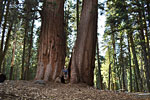 The High Sierra Trail (HST) starts in the Crescent Meadows area of Giant Forest, among some of the worlds largest trees. About a mile in, this conjoined giant Sequoia was split by fire. |
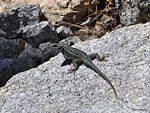 From atop boulders, brave and endearingly curious blue lizards study you as long as possible before dashing away. |
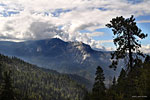 The sky was choked up with clouds on day one, and soon the forest was shrouded with mist and fog. Late afternoon brought drizzle and rain showers. Looking south at Castle Rocks. |
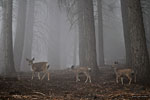 On that first foggy day, I came face to face with a black bear cub and numerous families of deer - this one a few feet from the Bear Paw Ranger Station on the climb up to Hamilton Lakes. |
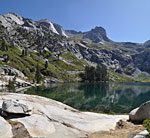 Morning dawns clear and dry on Hamilton Lake. Looking east from the granite-lined shore up towards the ridgeline that holds Kaweah Gap |
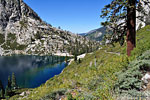 Hamilton assumes amazing shades of blue as you climb around and above it. The designated campsite area is above the flat rocks on this, the western lakeshore. |
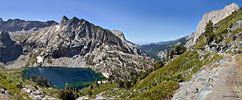 The HST ascends the north valley wall above the lake, the high cliffs of Valhalla peering out at right. Smallish lower Hamilton Lake is a short ways down the valley out of sight. |
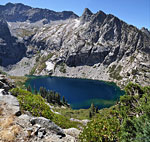 Giant trees along the shore fool the eye as to the actual scale |
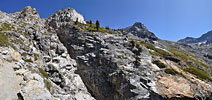 After a couple of miles up, the trail follows the contours of a large, deep crevice in the canyon wall, where there's a tunnel. You can see a notch in the overhanging cliff where the trail turns in. |
 The HST tunnel in the deep gouge of a side canyon |
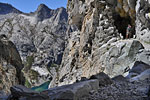 Hamilton Lake seems like miles below |
|
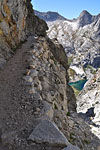 The narrow trail skirts the lip of a very steep cliff |
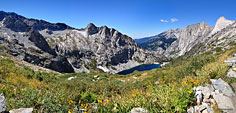 The trail climbs above treeline through grass and shrubs. This panorama west shows the sheer cliff escarpment known as Valhalla rising above the NW end (right side) of the lake. |
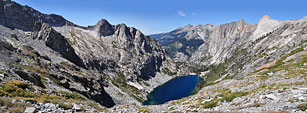 I climbed a boulder off trail to get this sweeping view of Hamilton Lk., her surrounding peaks, the High Sierra Trail and the valley west down to Bear Paw Meadow |
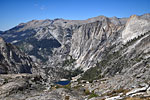 A last look back at Hamilton Lk. and Valhalla before the trail climbs around the mountain |
||
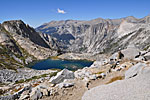 A Park Service trail crew takes a break above a brilliant blue tarn |
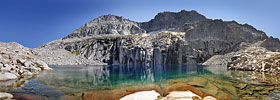 Precipice Lake is almost completely hidden from the trail in a large bowl near the top of Kaweah Gap. The magical blue water color was lost in Ansel Adams famous 1932 photo taken here. |
 On the east side of Kaweah Gap, a new mountainscape is revealed. In this 230 degree panorama, Nine Lakes Basin is on the left (north-northeast) To the right is the grand rounded valley known as the Big Arroyo going due south, lined with tall, rugged peaks |
|||
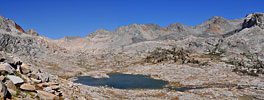 First of the Nine Lakes. Streams cascade down from the others, which are beyond and above it out of sight behind the mounds. |
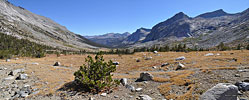 View south down the Big Arroyo. It's several miles around the bend before the Kaweah range comes into view on the left |
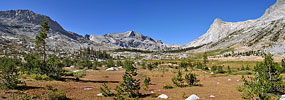 North from the Big Arroyo towards Nine Lakes Basin and Kaweah Gap, which is the deep notch on the left center side of the ridgeline, right of the tallest tree. |
|||
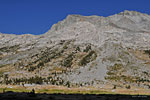 Deer (bottom center) cross Big Arroyo Creek out of the shadow of encroaching evening. |
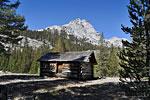 On day 3, the Big Arroyo cabin below Lippincott Mtn., where the Black Rock Pass trail splits from the HST, turning west and climbing 1200' to the Little Five Lakes. |
 180 degree panorama of the Kaweah's. After many miles of climbing up through the forest from the floor of the Big Arroyo, with only tentative, partial views through the trees, the trail at last reaches a ridge offering an unobstructed view of the dramatic Kaweah Range. |
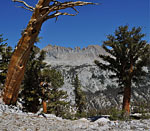 Ancient trees crowning the ridgeline above the Big Arroyo frame Red and Second Kaweah |
||
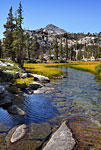 An outlet stream of the first of the Little Five Lks. with its lush, grassy banks. |
 East across Little Five Lakes no. 1, the Kaweah range rising above it on the far side of the Big Arroyo. |
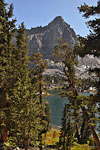 Initial glimpse of the first of the Big Five Lakes, guarded by a rugged peak. |
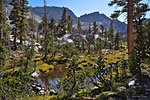 Much of Lake 2's north shore is tree-covered boulders. Between this natural levy and the forest are a series of shallow drainage streams connected by wetland meadows that parallel the shore. |
||
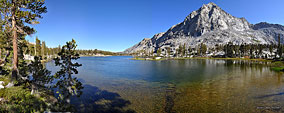 The second Big Five lake is large and amoeba-shaped, with granite shores and islets. |
 View east over Big Five Lake no.2 from my campsite, Mt. Kaweah in the distance. The late afternoon colors were magical, and not retouched. |
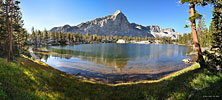 Early morning and farewell to Big Five Lake no.1 |
|||
 Climbing above the Little Five Lakes on the Black Rock Pass trail, looking back east at the Kaweah's. |
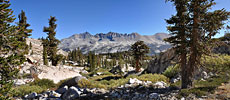 Massive pines at the edge of the treeline |
||||
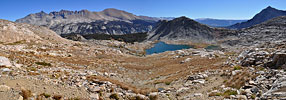 Looking back east and south from the Black Rock Pass trail over the Little Five Lakes plateau, and across the Big Arroyo to the Kaweahs |
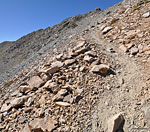 Near the top of Black Rock Pass, the grade is extremely steep, in places almost 40 degrees Near the top of Black Rock Pass, the grade is extremely steep, in places almost 40 degrees |
 Final look back at the Kaweahs and most of the Little Five Lakes from the top of Black Rock Pass. |
|||
 First look west at the Cliff Creek valley from the top of Black Rock Pass. At left are the peaks above Sawtooth Pass and 3 awesome stairstep lakes cascading into one another to form Cliff Creek. |
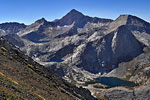 Columbine Lake(top), Cyclamen Lake and Spring Lake, below massive sheer cliffs |
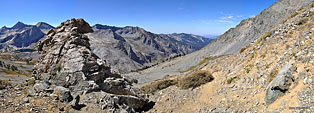 A unique rock formation on the Black Rock Pass trail, which follows the valley west (right) down |
|||
.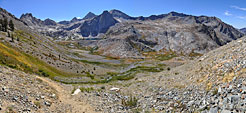 From the top of Black Rock Pass, the trail switchbacks endlessly down and still remains high above the canyon floor. |
 Looking back up to Black Rock Pass (top left), almost a mile up the mountain |
 360 degree pano of Cliff Creek valley 2 miles west below Black Rock Pass. Center left is east, center right is west |
|||
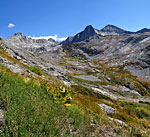 Looking east back up to the lakes basin |
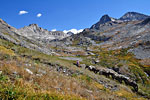 A horseman leads his mule train up towards Black Rock Pass |
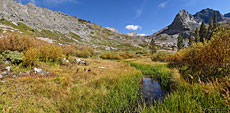 After the stark, rugged pass, the trail descends into a lush valley |
 Fall colors in the high Sierra |
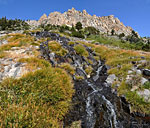 Cascades splash down the canyon walls from high lakes |
|
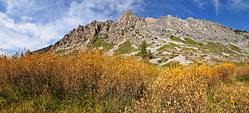 Rugged ridgeline 3 miles west below Black Rock Pass |
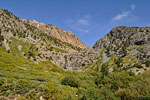 The trail drops 1000's of feet as it descends the Cliff Creek valley. Looking east back up the mountain the way I came. |
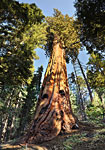 Ancient giant catches evening light in Redwood Mdw. grove |
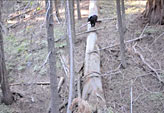 A black bear debates whether to continue up towards me on this giant dead Sugar Pine or play it safe. This is a screen capture of a video which I'll post when I get the file reduced for web viewing |
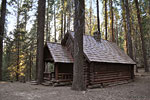 The handsome log lodge at Redwood Meadows, boarded up for the season days earlier |
|
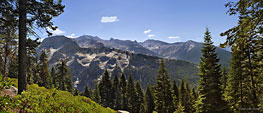 Vista east from trail between Redwood Mdw. and Bear Paw Mdw. |
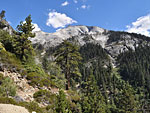 High dome mountain east of Bear Paw Mdw. |
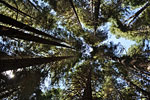 Canopy of immense Sugar Pines |
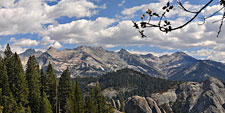 View east of the peaks of the Great Western Divide from the High Sierra Trail west of Bear Paw Mdw. |
||
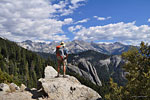 The final day, looking back east and soaking up the views I'd missed on the foggy hike in |
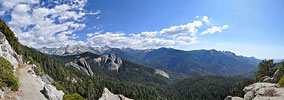 The High Sierra Trail to the Great Western Divide |
 As the HST winds around the mountains and returns west to Crescent Mdws., the Great Western Divide (left) slowly disappears from view. Just left of center is Cliff Creek valley, which I descended from Black Rock Pass. At right is Castle Rocks. |
|||
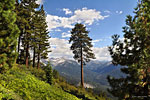 Land of giants |
 Magnicifent Sugar Pines tower over the landscape |
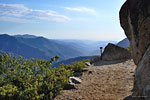 Looking west from Eagle View |
 Moro Rock at the southern edge of Giant Forest, draws closer, signaling the end to the journey. From atop the giant dome, there's a commanding 360 degree view of the park. People can be seen silhouetted on the summit from miles away. |
More photos in the Trip Report top of page |
|
TOP
Since 10.09
